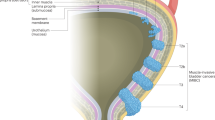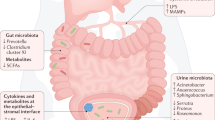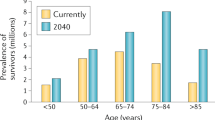Abstract
The association between aging and cancer is well exemplified by bladder cancer: with advancing age, the risk of developing bladder cancer increases, and patients' clinical presentation and outcomes worsen. Care for elderly patients with bladder cancer requires specific knowledge of many key geriatric clinical issues in order to determine optimal treatment plans. While numerous studies have tried to address the role of urologic intervention for elderly patients with bladder cancer, many studies fail to incorporate a component of true functional assessment. Evaluation tools that incorporate comorbidities, disabilities and functional status will need to be developed, as chronological age is a poor predictor of treatment outcomes. Additionally, further research is necessary to better understand the basic mechanisms that predispose elderly patients to develop this costly and life-threatening disease. This Review examines the current literature evaluating the clinical and mechanistic interactions between aging and bladder cancer, and suggests the formulation of a research agenda to address the issues raised.
Key Points
-
The annual number of bladder cancer cases in the US is increasing, with the elderly representing the largest group at risk
-
While age seems to adversely affect treatment outcomes for patients with all stages of bladder cancer, the optimum management of geriatric patients remains unclear
-
The majority of the data for treatment outcomes in elderly patients come from retrospective data analyses that are limited by selection biases and lack of a true assessment of physiologic reserves in the elderly
-
Current research into the etiology of bladder cancer in the elderly indicates a potential role for epigenetic events that accumulate over time, as opposed to repeated genetic damage
-
Future research agendas should be established to study the biology and physiology of aging as it relates to the development and progression of bladder cancer in the elderly, from the perspective of both basic mechanistic and clinical outcomes trials
This is a preview of subscription content, access via your institution
Access options
Subscribe to this journal
Receive 12 print issues and online access
$209.00 per year
only $17.42 per issue
Buy this article
- Purchase on Springer Link
- Instant access to full article PDF
Prices may be subject to local taxes which are calculated during checkout


Similar content being viewed by others
References
Edwards BK et al. (2002) Annual report to the nation on the status of cancer, 1973–1999, featuring implications of age and aging on US cancer burden. Cancer 94: 2766–2792
Serrano M and Blasco MA (2007) Cancer and ageing: convergent and divergent mechanisms. Nat Rev Mol Cell Biol 8: 715–722
Lichtman SM et al. (2007) Geriatric oncology: a field coming of age. J Clin Oncol 25: 1821–1823
Lynch CF and Cohen MB (1995) Urinary system. Cancer 75: 316–329
American Cancer Society (online 2008) Cancer Facts & Figures 2008 [http://www.cancer.org/downloads/STT/2008CAFFfinalsecured.pdf] (accessed 21 January 2009)
Schultzel M et al. (2008) Late age (85 years or older) peak incidence of bladder cancer. J Urol 179: 1302–1305
Prout GR Jr et al. (2005) Age and comorbidity impact surgical therapy in older bladder carcinoma patients: a population-based study. Cancer 104: 1638–1647
Konety BR and Joslyn SA (2003) Factors influencing aggressive therapy for bladder cancer: an analysis of data from the SEER program. J Urol 170: 1765–1771
Briggs NC et al. (1992) Age as a predictor of an aggressive clinical course for superficial bladder cancer in men. Cancer 69: 1445–1451
Ries LA et al. (online 31 December 2008) SEER Cancer Statistics Review, 1975–2005 [http://seer.cancer.gov/csr/1975_2005/] (accessed 21 January 2009)
Cooksley CD et al. (2008) Clinical model of cost of bladder cancer in the elderly. Urology 71: 519–525
Joudi FN et al. (2006) The impact of age on the response of patients with superficial bladder cancer to intravesical immunotherapy. J Urol 175: 1634–1639
Herr HW (2007) Age and outcome of superficial bladder cancer treated with bacille Calmette–Guérin therapy. Urology 70: 65–68
Rodin MB and Mohile SG (2008) Assessing decisional capacity in the elderly. Semin Oncol 35: 625–632
Wood DP Jr et al. (1987) Radical cystectomy for carcinoma of the bladder in the elderly patient. J Urol 138: 46–48
Skinner EC et al. (1984) Radical cystectomy in the elderly patient. J Urol 131: 1065–1068
Ogawa A et al. (1985) Treatment of bladder carcinoma in patients more than 80 years old. J Urol 134: 889–891
Chamie K et al. (2008) Cystectomy in the elderly: does the survival benefit in younger patients translate to the octogenarians? BJU Int 102: 284–290
Nielsen ME et al. (2007) Advanced age is associated with poorer bladder cancer-specific survival in patients treated with radical cystectomy. Eur Urol 51: 699–706
Figueroa AJ et al. (1998) Radical cystectomy for elderly patients with bladder carcinoma: an updated experience with 404 patients. Cancer 83: 141–147
Fried LP et al. (2001) Frailty in older adults: evidence for a phenotype. J Gerontol A Biol Sci Med Sci 56: M146–M156
Soulié M et al. (2002) A multicenter study of the morbidity of radical cystectomy in select elderly patients with bladder cancer. J Urol 167: 1325–1328
Gamé X et al. (2001) Radical cystectomy in patients older than 75 years: assessment of morbidity and mortality. Eur Urol 39: 525–529
Zebic N et al. (2005) Radical cystectomy in patients aged ≥75 years: an updated review of patients treated with curative and palliative intent. BJU Int 95: 1211–1214
Koppie TM et al. (2008) Age-adjusted Charlson comorbidity score is associated with treatment decisions and clinical outcomes for patients undergoing radical cystectomy for bladder cancer. Cancer 112: 2384–2392
Stroumbakis N et al. (1997) Radical cystectomy in the octogenarian. J Urol 158: 2113–2117
Weizer AZ et al. (2007) Performance status is a predictor of overall survival of elderly patients with muscle invasive bladder cancer. J Urol 177: 1287–1293
Feng Z et al. (2007) Declining p53 function in the aging process: a possible mechanism for the increased tumor incidence in older populations. Proc Natl Acad Sci USA 104: 16633–16638
Stuart GR et al. (2000) Mutation frequency and specificity with age in liver, bladder and brain of lacI transgenic mice. Genetics 154: 1291–1300
Maruyama R et al. (2001) Aberrant promoter methylation profile of bladder cancer and its relationship to clinicopathological features. Cancer Res 61: 8659–8663
Marsit CJ et al. (2006) Carcinogen exposure and gene promoter hypermethylation in bladder cancer. Carcinogenesis 27: 112–116
Jones PA et al. (1998) DNA methylation in bladder cancer. Eur Urol 33 (Suppl 4): 7–8
Marsit CJ et al. (2007) Promoter hypermethylation is associated with current smoking, age, gender and survival in bladder cancer. Carcinogenesis 28: 1745–1751
Habuchi T et al. (2001) Hypermethylation at 9q32–33 tumour suppressor region is age-related in normal urothelium and an early and frequent alteration in bladder cancer. Oncogene 20: 531–537
Bornman DM et al. (2001) Methylation of the E-cadherin gene in bladder neoplasia and in normal urothelial epithelium from elderly individuals. Am J Pathol 159: 831–835
Gu J et al. (2005) Roles of tumor suppressor and telomere maintenance genes in cancer and aging—an epidemiological study. Carcinogenesis 26: 1741–1747
Rodin MB and Mohile SG (2007) A practical approach to geriatric assessment in oncology. J Clin Oncol 25: 1936–1944
Walston J et al. (2006) Research agenda for frailty in older adults: toward a better understanding of physiology and etiology: summary from the American Geriatrics Society/National Institute on Aging Research Conference on Frailty in Older Adults. J Am Geriatr Soc 54: 991–1001
Monfardini S and Basso U (2007) Oncological causes of frailty in older cancer patients. Eur J Cancer 43: 1230–1231
Michaud DS (2007) Chronic inflammation and bladder cancer. Urol Oncol 25: 260–268
Taylor JA et al. (2006) Null mutation in macrophage migration inhibitory factor prevents muscle cell loss and fibrosis in partial bladder outlet obstruction. Am J Physiol Renal Physiol 291: F1343–F1353
Taylor JA III and Kuchel GA (2006) Detrusor underactivity: clinical features and pathogenesis of an underdiagnosed geriatric condition. J Am Geriatr Soc 54: 1920–1932
Leng SX et al. (2007) Inflammation and frailty in older women. J Am Geriatr Soc 55: 864–871
Acknowledgements
This work was supported by grants from the American Cancer Society MRSG-08-270-01-CCE (JAT), the National Institutes of Health R01-AG028657 (GAK, JAT), a Dennis W Jahnigen Career Development Award from the American Geriatrics Society (JAT) and the Travelers Chair in Geriatrics and Gerontology (GAK).Charles P Vega, University of California, Irvine, CA, is the author of and is solely responsible for the content of the learning objectives, questions and answers of the Medscape-accredited continuing medical education activity associated with this article.
Author information
Authors and Affiliations
Corresponding author
Ethics declarations
Competing interests
The authors declare no competing financial interests.
Rights and permissions
About this article
Cite this article
Taylor, J., Kuchel, G. Bladder cancer in the elderly: clinical outcomes, basic mechanisms, and future research direction. Nat Rev Urol 6, 135–144 (2009). https://doi.org/10.1038/ncpuro1315
Received:
Accepted:
Issue Date:
DOI: https://doi.org/10.1038/ncpuro1315
This article is cited by
-
Clinical outcome and quality of life in octogenarian patients with muscle-invasive urothelial carcinoma of the bladder treated with radical cystectomy or transurethral resection of the bladder tumor: a retrospective analysis of 143 patients
International Urology and Nephrology (2022)
-
Assessment of 5-year overall survival in bladder cancer patients with incidental prostate cancer identified at radical cystoprostatectomy
International Urology and Nephrology (2019)
-
Fruit and vegetable intake and the risk of recurrence in patients with non-muscle invasive bladder cancer: a prospective cohort study
Cancer Causes & Control (2018)
-
Association of benign prostatic hyperplasia and subsequent risk of bladder cancer: an Asian population cohort study
World Journal of Urology (2018)
-
The diagnostic accuracy of urine-based tests for bladder cancer varies greatly by patient
BMC Urology (2016)



